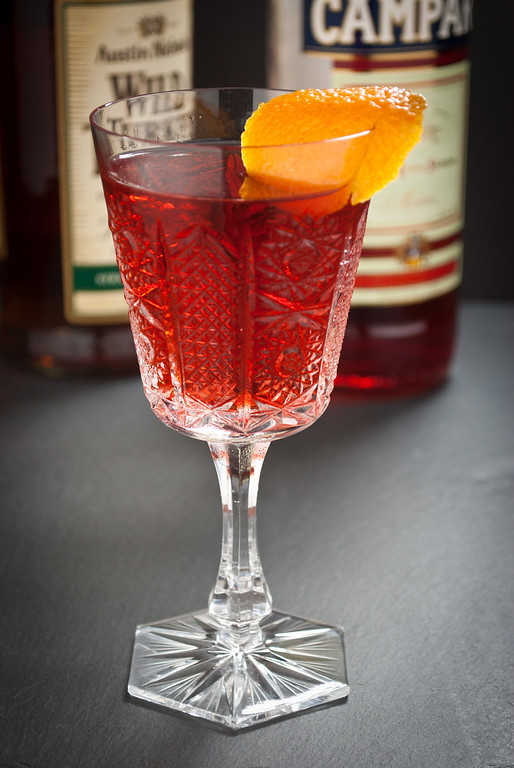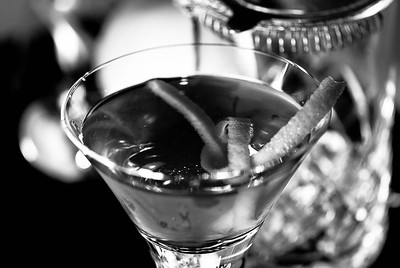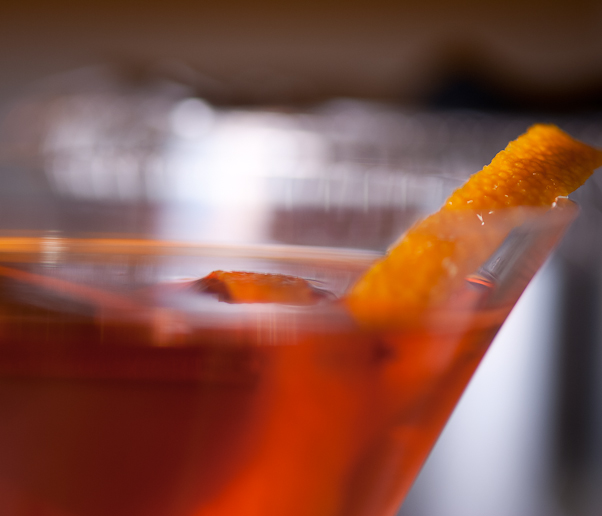The 1794 Cocktail is a welcome modernization of the Boulevardier, whiskey-heavy, with rye in place of bourbon. Attributed to Dominic Venegas, it is a natural evolution of that drink, and changes a classic but not-so-good mishmash into a deliciously bright and drinkable Manhattanesque whiskey cocktail.
The original Boulevardier is typical of the Prohibition-era expatriate cocktail. First published by Harry McElhone in 1927, it combines good old American bourbon with a then-unknown European amaro, Campari:
Boulevardier Cocktail
- 1 oz Bourbon Whiskey
- 1 oz Sweet Vermouth
- 1 oz Campari
Combine ingredients and stir until very cold; strain into a chilled cocktail glass.
Where did the Parisians get all that Bourbon during Prohibition? There must be a story there somewhere…
Less typical is that the Boulevardier, like its more famous cousin, the Negroni, is an equal parts drink. These are eye-catching as a class, some of them even delicious if made properly, but with their arbitrary and unwavering proportions they fight an uphill battle for credibility as anything more than parlor tricks. Negroni has succeeded; others (including Boulevardier), not so much.
The secret of this parlor trick, of course, is to balance the intensity, rather than the quantity, of each constituent in order to balance the drink. It works with the Negroni’s gin—if you can find the right gin—but matching the intensity of Campari with whiskey is not an easy thing. Campari can be a difficult and overbearing ingredient.
In the Boulevardier, the bourbon doesn’t really match all that well, but it makes a fine starting point—increasing the whiskey actually improves the drink. And that is where the 1794 comes into the picture.

The 1794 doubles down on the whiskey, and substitutes the spicier notes of rye. It provides what amounts to a nice, bright Manhattan—rye driven, with a slightly floral, or at least herbal, nose, a middle taste of sweet and bitter, and a crisp and clean aftertaste.
1794 Cocktail
- 2 oz Rye whiskey (Wild Turkey 101 or Rittenhouse 100)
- 1 oz Sweet Vermouth (M&R Rosso)
- 1 oz Campari
- 1 dropper Bittermen’s Xocolatl Mole bitters (optional)
- orange or lemon twist for garnish (optional)
Combine ingredients and stir until very cold; strain into a chilled cocktail glass, optionally garnish with orange or lemon twist.
McElhone’s original called for bourbon, but it is too sweet for the 1794. This is a good showcase for high-proof ryes. Besides, bourbon isn’t really in the spirit of this drink—it’s called the “1794,” after all, commemorating the Whiskey Rebellion; the whiskey of the day, the macguffin at the heart of the conflict, was rye whiskey. (Jay Hepburn at Oh Gosh! has suggested that a rye-forward bourbon like Buffalo Trace might be an acceptable substitute; he’s really exploring adjustments to salvage the original Boulevardier, and along the way basically reinvents the 1794. I didn’t have any Buffalo Trace, but I did try it with some rye-heavy Bulleit; it was… okay… but I’ll stick to the rye on this one.
Given the “acquired taste” reputation of Campari, I thought I’d try substituting a less aggressive amaro to see what happened. Aperol came to hand, mostly because it stuck to Campari’s ostentatious red color scheme. The result is drinkable, but lackluster compared to the Campari version; something in the Campari provides a spicy brightness that just isn’t there in the more orangy, earthy Aperol variant.

If you want to tart this drink up a bit, Jessica at Cocktail Virgin describes a variant that includes Bittermen’s Xocolatl Mole Bitters. I tried it, it’s good. Very good. The chocolate offers a richness to the flavor palate, and helps balance and round the flavors in the mix.
As for the Whiskey Rebellion: the result of that uprising in terms of winners and losers has always been open to interpretation. The tax protesters sort of won, mostly lost; the government mostly compromised, sort of won. One thing I know is that whiskey drinkers won—among other things, the 1794 conflict contributed to the invention of the Bourbon whiskey industry, as many whiskey-making farmers of western Pennsylvania moved west into the corn-friendly land of Kentucky, or south to French New Orleans, and farther from the view of Federalist George Washington’s excise tax collectors.
“1794 Cocktail — the Boulevardier Comes to Manhattan” at cold-glass.com : All text and photos © 2010 Douglas M. Ford. All rights reserved.

I have always wanted to try a martini.
Go for it.
Thanks to this article, I made a 1794 for the first time last night.
I’ve not tasted either the Rittenhouse rye, nor a Wild Turkey rye whiskey. But I did have Bulleit’s 95 straight rye readily at hand.
I garnished with an orange slice. I opted to rim the glass with the orange (as one would do for a Negroni). Though conscious that too much orange can overly sweeten a drink, but I was countering two things. First, Bulleit’s 95 straight rye is a fairly spicey whiskey, due in part to it’s 95% rye mash. Second, my wife (who does not often request a cocktail, but did on this occasion), does not care for too much of Campari’s bitterness.
The net result was a very successful cocktail. It was not too sweet, and we had the delightful slight bitterness from Campari bubble up through the other flavors only in the lingering aftertaste.
Like the Negroni, the 1794 features the dance of the various complex flavors in Campari and in sweet vermouth in a lovely 1 to 1 balance against each other. What surprised me most is that one could suppose the 1794 may be fairly whiskey forward in taste. But the ratios of these ingredients melds the flavors together well, so that none seemed to be ahead of the other, and instead the cocktail creates it’s own overall flavor.
Anyway, thank you for sharing this recipe. Two thumbs up from this household!
Yes, I’ve often made the 1794 with Bulleit’s rye, and I think it’s a good choice. The orange rim is an interesting idea, I’ll give a try next time.
Two thumbs up, I can’t ask for more. Thanks!
I’ve been tweaking my Manhatten’s this spring . So far after my Dad’s Crown Royal , Dry vermouth, cherry. I went to a Bullet Rye , dry vermouth, & cherry. Now I’m working on a nice High West Double Rye , Dolin’s Dry Vermouth with a twist ( oh yeah , biitters too ).
Very Good !
I like the dry , spicy taste of a rye Hattie, it’s like bread , bourbon = corn bread , rye = rye bread , right now I’m liking the dry spicy finish.
My brother-in-law would likely agree with you on the dry Manhattan; I’m a confirmed sweet vermouth guy, though I do enjoy a perfect Manhattan (half dry vermouth, half sweet) from time to time. And that High West rye makes a very pleasant cocktail. Thanks!
I love this cocktail – so much, in fact, that I’m oak-aging a batch to serve at my wedding.
Just came across this similar cocktail: The Pabo Amargo. Haven’t had a chance to try it yet, but it sounds delicious.
http://drinks.seriouseats.com/2013/05/manhattan-cocktail-classic-2013-recap-new-york-public-library-drinks-slideshow.html#show-327297
http://www.manhattancocktailclassic.com/cocktails/pabo_amargo.html
Oak-aged 1794 cocktails—what a great idea, I hope that works out really well. And congratulations on your wedding.
I love this cocktail – so much, in fact, that I’m oak-aging a batch to serve at my wedding.
Just came across this similar cocktail: The Pabo Amargo. Haven’t had a chance to try it yet (no Sherry on hand), but it sounds delicious.
http://drinks.seriouseats.com/2013/05/manhattan-cocktail-classic-2013-recap-new-york-public-library-drinks-slideshow.html#show-327297
http://www.manhattancocktailclassic.com/cocktails/pabo_amargo.html
Doesn’t work for me! wanted it to, but the campari at that percentage slimes it. Feels greasy. Better with just a splash of the C, then its a bitter replacement. I like Campari but it seems to dominate and i lost the rye leadership in my first attempt, which i treasure in this drink. thanks for the idea.
“Slimes it,” what an evocative phrase. I’m glad you gave it a try, and very glad you reported back. That use of Campari (and amaros in general) in small amounts as a substitute for bitters can provide very interesting combinations; thanks for the reminder— time for more experiments!
Nice drink, the 1794. I like it better than a Negroni. Thanks for this.
You’re welcome, Jake, thanks for commenting.
Expatriate (not expatriot).
A lovely blog.
Oof, fixed. That’s embarrassing. I can’t believe no one busted me for that before. Not even the spell-checker.
Thanks!
As an employee of Campari America in the US, i am very interested in the 1794 cocktail as well as the earlier comment about barrell aging it. I think i know what i am doing this weekend!
Thanks for sharing!
Yeah, I think I need a barrel, too. Thanks for checking in!
Is the 1794 an Old Pal with sweet vermouth? Or is the Old Pal a 1794 with dry vermouth?
Given that the Old Pal came first, I would say that the 1794 is an Old Pal with sweet vermouth. And that’s an interesting comparison, thanks.
I’m pretty sure they used Canadian Club in Paris back then. It’s used in pretty much everything else made in Paris during that era and substituting it with rye is the most popular tweak.
Thanks for the insight. I have never seen a reference to which whiskeys were preferred by Parisians in the ’20s, nor that CC was so popular.
How do you convert ‘a dropper’ to a number of dashes from a regular bottle? I found Fee Bros. chocolate mole bitters. Thanks!
Dunno. I think you just have to experiment to find out what’s right for you.
Doug,
Thanks for a great post! Frankly I’m a little confused because I thought the Boulevardier could use Bourbon or Rye. Needless to say, I was wrong.
I’m looking forward to experimenting with the 1794.
Thanks, Bill. I hope you enjoy the 1794 as much as I do.
I’m fond of Woodford’s Reserve on the rocks with a splash of Campari. Excellent drink
I look forward to giving that a try, thanks.
So, not to be a nuisance, but if you can lay your hands on some of the new Washington DC distillery DonCiccio’s “Luna Amara” as a more bitter substitute for the Campari you’ll get far more flavor notes. Campari has it’s place (blood orange + C = heaven) but for these more complex drinks an exploration onto the the new golden age of Amaris is worth the trip.
I’ve never seen Luna Amara in my region, but I’ll be watching for it now. And I agree, the growing availability of amari is providing lots of new things to explore.
My personal Boulevardier variation is to replace the Sweet Vermouth with Averna. However, that makes it a little overly bitter as a 1:1:1 drink, so I go with 1oz Bourbon or Rye (currently drinking one with Rittenhouse), 1oz Averna, 2/3 oz Campari. Orange twist to garnish.
Interesting. Sort of a cross between Boulevardier and the Black Manhattan. Thanks for the idea.
I had independently developed this and agree that 1:1:1 does not work. I find a ratio of 5:3:3 works best, using Rittenhouse, Martini Rosso and Campari. 2 /1/2 ounces Rye, 1 1/2 each of vermouth and campari, with ice. Slightly less Rye than your suggestion. Good year-round.
That would work pretty well. This drink is way up my list of favorites. Thanks!
Where can I find the glassware in the picture?
Hi, Brian, sorry to be slow answering. Worse yet, I have no idea what that glass is, I picked it up long ago in an antique shop. It has no markings to guide me about its maker, alas!
Thanks, Doug. I finally got aroud to playing with this. I’m using Carpano Antica Formula. Even at 1 oz I found the Campari overbearing. I’ve settled on about 1/3 oz as the sweet spot for me. This has become my go-to drink. Always look forward to the next Cold-Glass recipe and context. All the best and Happy Holidays.
Hi, Ron, yes, Campari is definitely an ingredient to match to your tastes. Upon reflection, I suppose the same could be said for most sweets and bitters. Thanks, and Happy Holidays to you, too.